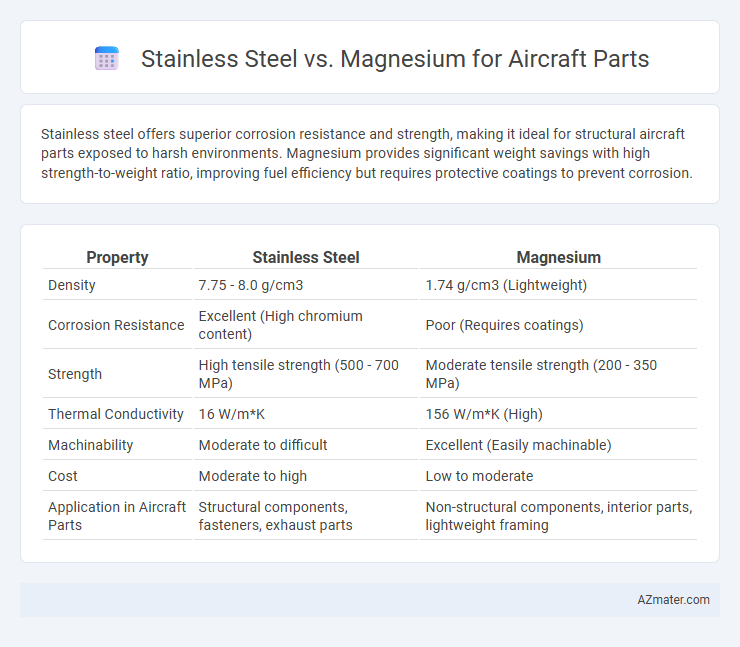Stainless steel offers superior corrosion resistance and strength, making it ideal for structural aircraft parts exposed to harsh environments. Magnesium provides significant weight savings with high strength-to-weight ratio, improving fuel efficiency but requires protective coatings to prevent corrosion.
Table of Comparison
| Property | Stainless Steel | Magnesium |
|---|---|---|
| Density | 7.75 - 8.0 g/cm3 | 1.74 g/cm3 (Lightweight) |
| Corrosion Resistance | Excellent (High chromium content) | Poor (Requires coatings) |
| Strength | High tensile strength (500 - 700 MPa) | Moderate tensile strength (200 - 350 MPa) |
| Thermal Conductivity | 16 W/m*K | 156 W/m*K (High) |
| Machinability | Moderate to difficult | Excellent (Easily machinable) |
| Cost | Moderate to high | Low to moderate |
| Application in Aircraft Parts | Structural components, fasteners, exhaust parts | Non-structural components, interior parts, lightweight framing |
Introduction to Aircraft Material Selection
Aircraft material selection prioritizes strength-to-weight ratio, fatigue resistance, and corrosion tolerance to ensure performance and safety. Stainless steel offers superior corrosion resistance and durability but is heavier, whereas magnesium provides exceptional lightweight characteristics with reduced fatigue strength and higher susceptibility to corrosion. Balancing these factors is essential for optimizing structural integrity and fuel efficiency in aerospace applications.
Physical Properties: Stainless Steel vs Magnesium
Stainless steel exhibits higher density (7.7-8.0 g/cm3) and tensile strength (505-827 MPa) compared to magnesium's lower density (1.7-1.8 g/cm3) and tensile strength (160-290 MPa), making magnesium preferable for weight-sensitive aircraft parts. Magnesium offers superior machinability and thermal conductivity (~156 W/m*K) but lower corrosion resistance and fatigue strength relative to stainless steel, which maintains greater durability in harsh environments due to its chromium content. The choice between stainless steel and magnesium depends on balancing structural strength, weight reduction, and environmental exposure in aerospace component design.
Weight Considerations in Aerospace Applications
Magnesium offers a significant weight advantage over stainless steel, with a density of approximately 1.74 g/cm3 compared to stainless steel's 7.9 g/cm3, making it ideal for aircraft parts where reducing mass is critical. The lighter weight of magnesium contributes to improved fuel efficiency and increased payload capacity in aerospace applications. Despite its lower density, magnesium alloys maintain sufficient strength and corrosion resistance required for many structural components, balancing weight reduction and performance.
Corrosion Resistance Comparison
Stainless steel exhibits superior corrosion resistance compared to magnesium due to its chromium content, which forms a passive oxide layer protecting the metal from oxidation and environmental degradation. Magnesium, while lightweight and advantageous for weight-sensitive aircraft parts, is highly susceptible to corrosion, especially in marine or humid environments, requiring protective coatings for durability. Consequently, stainless steel is preferred in critical aircraft components exposed to harsh conditions, balancing corrosion resistance with structural integrity.
Strength and Durability Factors
Stainless steel offers superior strength and corrosion resistance, making it highly durable for aircraft parts subjected to harsh environmental conditions. Magnesium is significantly lighter, enhancing fuel efficiency, but it has lower tensile strength and is more prone to corrosion and fatigue over time. The choice depends on balancing weight reduction with the need for structural integrity and long-term performance under stress.
Manufacturing and Machinability Differences
Stainless steel offers superior corrosion resistance and strength but requires higher machining forces and tooling wear due to its hardness, resulting in longer manufacturing cycles. Magnesium is significantly lighter and easier to machine, allowing for faster production and reduced energy consumption, but demands careful handling to prevent flammability risks and corrosion without adequate surface treatment. Choosing between stainless steel and magnesium involves balancing manufacturing efficiency with material performance and safety considerations in aircraft part production.
Cost Analysis: Initial and Lifecycle
Stainless steel exhibits higher initial material and manufacturing costs compared to magnesium due to its density and machining complexity, increasing upfront expenses for aircraft parts. Magnesium offers lower initial costs attributed to its lightweight properties and ease of casting, reducing fuel consumption and operational costs over the aircraft's lifecycle. Despite magnesium's cost benefits, its susceptibility to corrosion and lower fatigue resistance can raise maintenance expenses, potentially narrowing the total lifecycle cost advantage over stainless steel.
Environmental and Safety Concerns
Stainless steel offers superior corrosion resistance and fire retardancy compared to magnesium, reducing environmental hazards linked to metal degradation and combustion risks during aircraft operation. Magnesium's lightweight properties improve fuel efficiency but pose significant fire safety concerns due to its high flammability and difficulty to extinguish once ignited. Choosing stainless steel enhances aircraft safety and minimizes environmental impact related to toxic emissions and structural failures.
Real-world Aircraft Applications of Both Materials
Stainless steel is extensively used in aircraft components requiring high strength, corrosion resistance, and heat tolerance, such as landing gear, engine parts, and fasteners, due to its durability and resistance to fatigue. Magnesium, valued for its exceptional light weight and good mechanical properties, is commonly employed in aircraft interior structures, gearbox housings, and other applications where weight reduction is critical without compromising strength. Real-world aircraft designs often integrate both materials strategically, leveraging stainless steel's robustness for critical load-bearing parts and magnesium's lightweight advantage for enhancing fuel efficiency and payload capacity.
Final Recommendations for Material Choice
Magnesium offers a significant weight reduction of up to 35% compared to stainless steel, enhancing fuel efficiency and payload capacity in aircraft parts. Stainless steel provides superior corrosion resistance, mechanical strength, and durability, making it ideal for high-stress components exposed to harsh environments. Final recommendations favor stainless steel for critical structural parts requiring longevity and safety, while magnesium suits non-structural components where lightweight performance is paramount.

Infographic: Stainless steel vs Magnesium for Aircraft part
 azmater.com
azmater.com